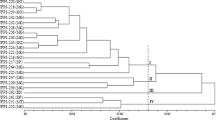Abstract
Variation in Italian germplasm of Phaseolus coccineus L. was assessed for seed traits and molecular markers. A total of 130 seeds and seedlings, five for each of 21 Italian landraces, an Italian commercial cultivar and four Mesoamerican landraces of P. coccineus, were analysed using seven selected PCR markers: three RAPDs, two ISSRs and two ETs. Seed weight of the Mesoamerican landraces was ≤1 g, whereas that of the Italian landraces varied from 1 g to 2.5 g and was related to their origin. Oval shape was more frequent, with round shape observed only in Mesoamerican landraces. Three seed coat colours were observed: white, violet mottled or spotted black and buff spotted brown, also this trait was related to the origin. The level of polymorphism detected by molecular markers was low but with significant discriminant power. ISSRs were the most effective markers prone to unravel molecular polymorphism. The within accession component of variation exceeded that among accessions, as expected for an allogamous species. However correct classification of the individuals was achieved performing either discriminant analysis of the seed phenotypic traits or cluster analysis of seedling similarity measure based on the whole banding patterns obtained by the three marker types. Our data suggest that the Italian farmers, starting with ancestral Mesoamerican runner bean introductions in Europe, bred their own landraces through selection for seed size and seed coat colour, but occasional gene flow maintained variability within landraces bred by different farmers in the same Italian Region. Selection favored molecular and seed trait uniformity within several landraces making them suitable for certification.




Similar content being viewed by others
References
Belaj A, Satovic Z, Cipriani G, Baldoni L, Testolin R, Rallo L, Trujillo I (2003) Comparative study of the discriminating capacity of RAPD, AFLP and SSR markers and of their effectiveness in establishing genetic relationships in olive. Theor Appl Genet 107:736–744
Campion B, Servetti E (1991) Breeding in the runner bean (Phaseolus coccineus L.) for the development of dwarf lines. J Genet Breed 45:173–180
Carlderon E, Velasquez L, Bressani R (1992) Comparative study of the chemical composition and nutritive value of runner bean (Phaseolus coccineus) and of common bean (Phaseolus vulgaris). Arch Latinoam Nutr 42(1):64–71
Dellaporta SL, Wood J, Hicks JB (1983) A plant DNA minipreparation: version II. Plant Mol Biol Rep 1:19–21
Dice LR (1945) Measures of the amount of ecologic association between species. Ecology 26:297–302
Gaitan-Solìs E, Duque MC, Edwards KJ, Tohme J (2002) Microsatellite repeats in common bean (Phaseolus vulgaris): isolation, characterization, and cross-species amplification in Phaseolus ssp. Crop Sci 42:2128–2136
Gawel M, Wisniewska I, Rafalski A (2002) Semi-specific PCR for the evaluation of diversity among cultivars of wheat and Triticale. Cell Mol Biol Lett 7:577–582
Gepts P, Debouk D (1991) Origin, domestication and evolution of the common bean (Phaseolus vulgaris L.). In: van Schoonhoven A, Voysest O (eds) Common beans: research for crop improvement. CAB, Oxon, UK, pp 7–53
Guerra-Sanz JM (2004) New SSR markers of Phaseolus vulgaris from sequence databases. Plant Breed 123:87–89
Hamann A, Zink D, Nagl W (1995) Microsatellite fingerprinting in the genus Phaseolus. Genome 38:507–515
IBPGR (now Biodiversity International) (1983) Descriptors for Phaseolus coccineus. AGPG: IBPGR/82/74, Rome, Italy
Nagaoka T, Ogihara Y (1997) Applicability of intersimple sequence repeat polymorphisms in wheat for use as DNA markers in comparison to RFLP and RAPD markers. Theor Appl Genet 94:597–602
Negri V, Tosti N (2002) Phaseolus genetic diversity maintained on-farm in Central Italy. Genet Resour Crop Evol 49:511–520
Nowosielski J, Podyma W, Nowosielska D (2002) Molecular research on the genetic diversity of Polish varieties and landraces of Phaseolus coccineus L. and Phaseolus vulgaris L. using the RAPD and AFLP methods. Cell Mol Biol Lett 7:753–762
Peakall R, Smouse PE (2005) GenAlEx 6: genetic analysis in excel. population genetic software for teaching and research. Australian National University, Canberra, Australia. http://www.anu.edu.au/BoZo/GenAlEx/
Raina SN, Rani V, Kojima T, Ogihara Y, Singh KP, Devarumath RM (2001) RAPD and ISSR fingerprints as useful genetic markers for analysis of genetic diversity, varietal identification, and phylogenetic relationships in peanut (Arachis hypogaea) cultivars and wild species. Genome 44:763–772
Rohlf FJ (1998) NTSYS-PC. Numerical taxonomy and multivariate analysis system, version 2.02. Exeter Software, Setauket, NY
Santalla M, Monteagudo AB, González AM, De Ron AM (2004) Agronomical and quality traits of runner bean germplasm and implications for breeding. Euphytica 135:205–215
Sicard D, Nanni L, Porfiri O, Bulfon D, Papa R (2005) Genetic diversity of Phaseolus vulgaris L. and P. coccineus L. landraces in Central Italy. Plant Breed 124(5):464–472
Souframanien J, Gopalakrishna T (2004) A comparative analysis of genetic diversity in blackgram genotypes using RAPD and ISSR markers. Theor Appl Genet 109:1687–1693
UPOV (2003) Runner bean (Phaseolus coccineus L.). Guidelines for the conduct of tests for distinctness, uniformity and stability. Geneva
Vos P, Hogers R, Bleeker M, Reijans M, van de Lee T, Hornes M, Frijters A, Pot J, Peleman J, Kuiper M, Zabeau M (1995) AFLP: a new technique for DNA fingerprinting. Nucleic Acids Res 23(21):4407–4414
Williams JG, Kubelik AR, Livak KJ, Rafalski JA, Tingey SV (1990) DNA polymorphisms amplified by arbitrary primers are useful as genetic markers. Nucleic Acids Res 18(22):6531–6535
Zietkiewicz E, Rafalski A, Labuda D (1994) Genome fingerprinting by simple sequence repeat (SSR)-anchored polymerase chain reaction amplification. Genomics 20:176–183
Acknowledgement
The present research was financed by the Italian Ministry of Education, University and Research, Project “SCRIGNO”, Legge 449/97.
Author information
Authors and Affiliations
Corresponding author
Rights and permissions
About this article
Cite this article
Acampora, A., Ciaffi, M., De Pace, C. et al. Pattern of variation for seed size traits and molecular markers in Italian germplasm of Phaseolus coccineus L.. Euphytica 157, 69–82 (2007). https://doi.org/10.1007/s10681-007-9397-3
Received:
Accepted:
Published:
Issue Date:
DOI: https://doi.org/10.1007/s10681-007-9397-3




